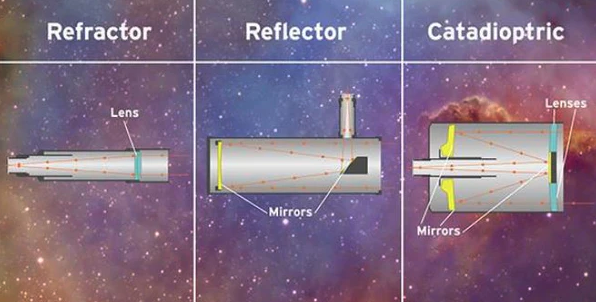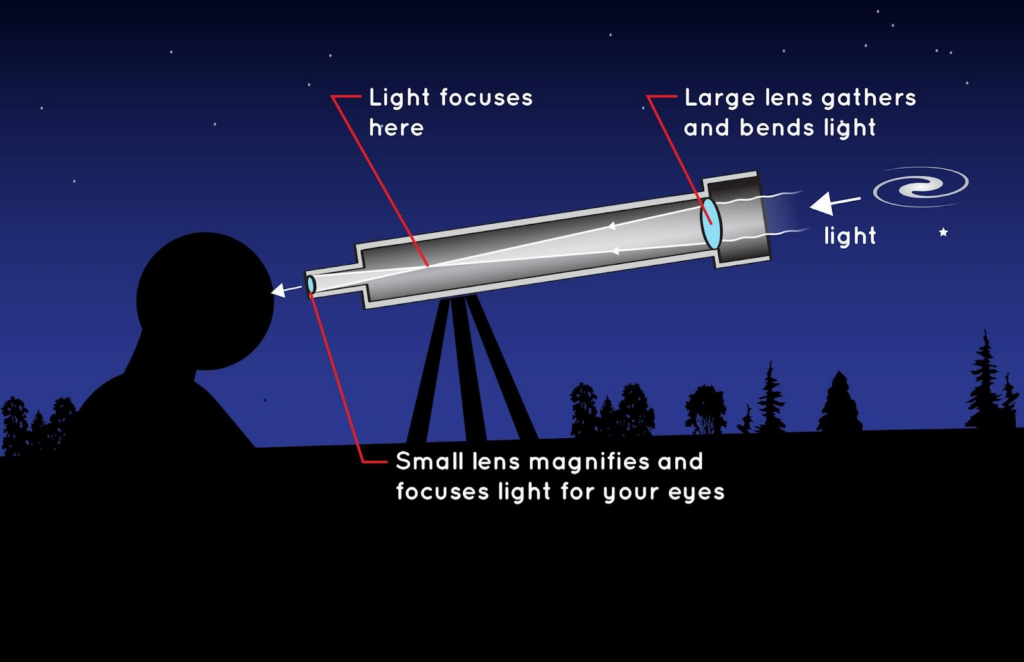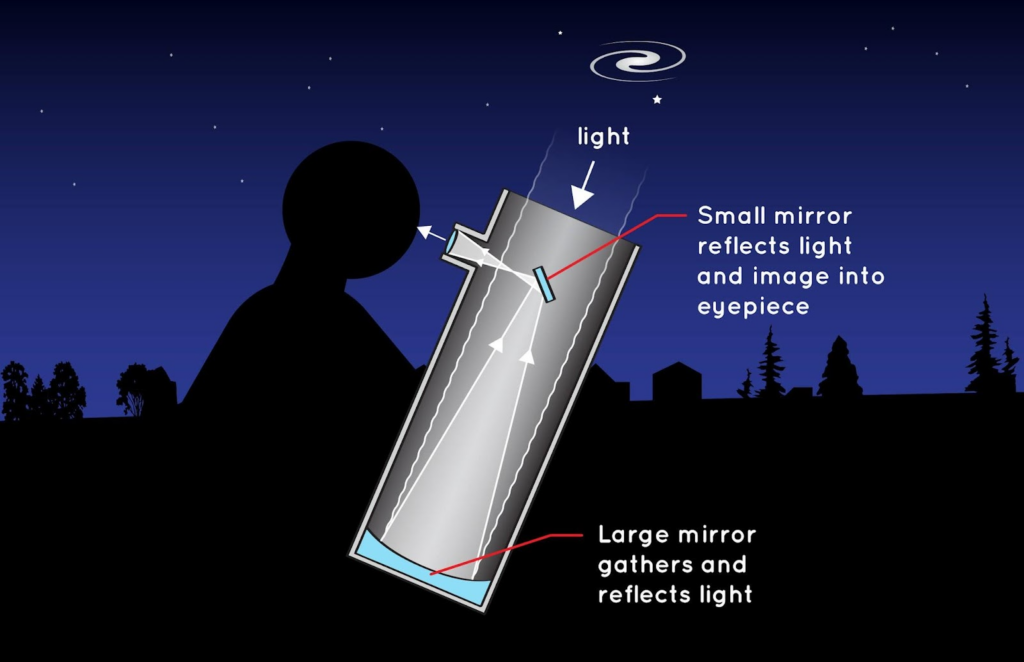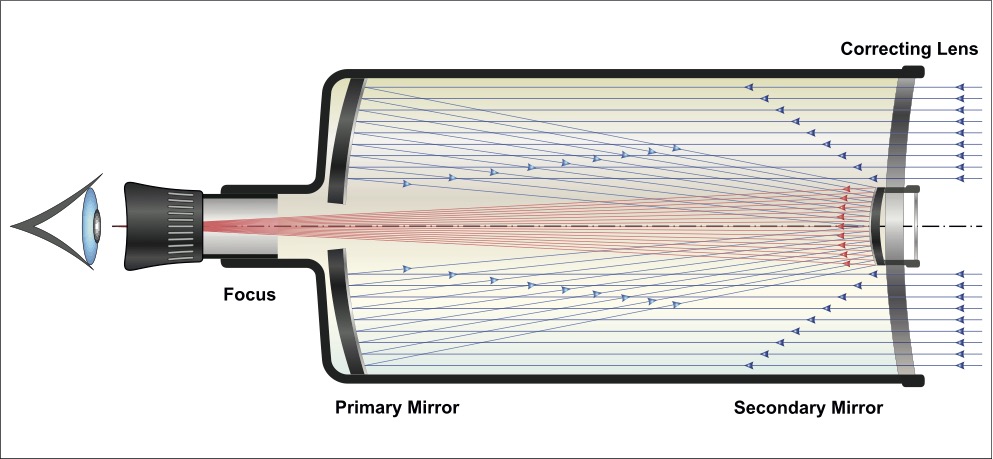The 3 Types of Telescopes- Different Ways to View the Beauty of Space
Trying to differentiate between the three types of telescopes can be confusing. There are three types of telescopes for backyard astronomers. Refracting, Reflecting, and Catadioptric are the most common telescopes for hobbyist astronomers.
The names of the telescope types can be confusing too! Refracting, Reflecting, and Catadioptric. What’s the function of each telescope? Let’s dig into telescopes and help you determine the best kind of backyard telescope for you!

Table of Contents
Three Types of Telescopes
Telescope manufacturing companies generally include the telescope type in the name of the telescope. Let’s take a look at the three types of telescopes.
- Celestron – 70mm Travel Scope – Portable Refractor Telescope
- SOLOMARK – 130EQ Newtonian Reflector Telescope
- SARBLUE – Mak60 Catadioptric Compound Telescope
| Telescope Type | Primary use |
|---|---|
| Refractor | Deep space objects |
| Reflector | Moon and planets |
| Catadioptric | Deep space, Moon, Planets |
Each telescope type has a “sweet spot” that will provide the optimal viewing for each celestial kind of viewing. The Refractor and Reflector telescopes allow you to pinpoint what type of astronomy you’re interested in and select an appropriate telescope. The targeted telescope application will give you precisely what you seek at a much lower price than a Catadioptric telescope.
Let’s look at each type of telescope and understand how they work.
Refracting Telescopes
Looking to peer into the Deep Sky? A refracting telescope might be a significant first step! In 1608 Hans Lipperhey stuck two glass lenses into a tube and invented the telescope. The following year Galileo Galilei continued the development and discovered the solar system in more detail than had ever been seen.

As seen in the image above, light travels straight through the center of the telescope when it passes through a refractor telescope. The light passing through a single lens before reaching the eyepieces equates to fewer imaging issues. The simplicity of the design equates to rock-solid optical alignment.
- Light enters the telescope through the “primary” (or large) lens.
- The light exits the telescope through the “secondary” lens, the Eyepiece.
- Magnification occurs from the use of different eyepiece lenses.
- The Eyepiece is located at the rear of the telescope.
- It’s very common to have an eyepiece with a mirror prism. The Eyepiece is configured at a 90-degree angle. The interior of the 90-degree “corner” has a mirror installed at 45 degrees. The light hits the Mirror and is reflected “up” to the Eyepiece. The reflection allows you to look “down’ on the Eyepiece rather than needing to be positioned directly ‘behind’ the telescope.
- Focus occurs by moving the Eyepiece closer or further away from the telescope’s barrel. It is usually done with a knob.
- A refracting telescope bends the light into focus with an optical lens.
Best Objects to View
Deep Sky Objects (DSO) are the bread and butter for a refractor telescope. DSOs reside outside our solar system. What are the different types of DSOs?
- Nebula: Clouds of gas and dust (in space).
- Star Clusters: A group of stars bound together through gravity and have a shared point of origin.
- Galaxies: Millions, perhaps billions of stars, are held together by gravitational forces. (Consider the Milky Way.)
Reflecting Telescopes
If you have plans to view the moon or planets but not Deep Space, a reflecting telescope is a great option. In 1663 James Gregory published a design for a reflecting telescope. In 1668 Issac Newton created a functional reflecting telescope.

The image above demonstrates how light travels when it enters a reflecting telescope.
- Light enters the telescope through the “primary” (or large) lens.
- The light travels through the telescope’s body and is bounced (reflected) back toward the front of the telescope.
- The light traveling back up the telescope body strikes a secondary mirror and is reflected into the Eyepiece.
- Notice the different position of the Eyepiece in the reflector telescope versus the refractor telescope?
- A reflecting mirror “reflects” the light into focus.
Catadioptric Telescopes
A catadioptric telescope combines both a reflecting and refractor telescope. In 1930 Bernhard Schmidt developed the design for a telescope with concave mirrors. The concave mirror design corrected for off-axis imaging artifacts like astigmatism and coma.
A catadioptric telescope is lighter and easier to mechanically manipulate than a reflector or refractor telescope with an equal-sized sized primary lens. Catadioptric telescopes (sometimes called Compound Telescopes) are suitable for “all-around” astronomy observations.

The image above demonstrates how light travels when it enters a Catadioptric telescope.
- Light enters the telescope through the collection lens.
- The light travels through the telescope’s body and strikes a concave curved Primary Mirror. The shape of the Primary Mirror directs all of the light “in” toward the smaller Secondary Mirror.
- The reflected light travels back up the telescope and strikes a Secondary convex-shaped Mirror.
- Light from the Secondary Mirror travels to the mechanical mechanism to adjust the focus and then travels onto the Eyepiece.
There are four primary Catadioptric telescope designs.
1. Schmidt-Cassegrain (SCT)
- A solid telescope selection for both Planetary and Deep Space astronomy
- Long focal lengths due to “folded” optical path. (The light travels from the collection lens to the Primary Mirror to the Secondary Mirror to the Eyepiece.)
- Clean image with reduced aberrations
- The Celestron – NexStar 8″ Schmidt-Cassegrain Telescope is an excellent example of a Schmidt-Cassegrain Telescope.
2. Maksutov-Cassegrain
- Good choice for viewing the moon and planets
- Similar configuration to the Schmidt-Cassegrain. The Maksutov-Cassegrain telescope has a thicker corrector plate than a Schmidt-Newtonian telescope. The thicker plate results in it taking a longer time for the telescope to acclimate to outdoor temperatures than the SCT will take.
- The Orion 10022 StarMax 90mm TableTop Maksutov-Cassegrain Telescope has surprised users with its ease of use and quality image.
3. Schmidt-Astrograph
- The Schmidt-Astrograph is a telescope designed for astrophotography, not visual observations.
- They are suitable for searching for comets and asteroids as they perform an automated survey of the night skies.
- The ROWE-ACKERMANN SCHMIDT ASTROGRAPH (RASA 8) is a great system, but remember that it’s all about astrophotography. There are no eyepieces for viewing.
4. Schmidt-Newtonian
- The telescope combines the Reflector and Schmidt-Cassegrain (SCT) telescopes functionality.
- A corrector lens minimizes imaging aberrations.
- Larger field (FOV) of view than Maksutov-Cassegrain.
- A larger FOV equals less contrast.
- Good choice for Deep Space Objects and a less than ideal choice for planetary observations.
Three Types of Telescopes-Which is Right for you?
Deciding which telescope is right for you may be a challenge. Refractor telescopes are a solid choice for observing Deep Space Objects. A Reflector Telescope is a good choice if you want to watch the moon or the planets. A Refractor or Reflector telescope is a cheaper (not cheap!) alternative to a Catadioptric telescope.
A Catadioptric telescope is an excellent selection if you want to observe Deep Space Objects, planets, and the moon. A Catadioptric telescope will make a more significant dent in your finances than a Reflector or Refractor telescope. The Catadioptric telescope may be the perfect choice if you’re looking for a telescope to grow with as your astronomy interest increases.
A Catadioptric telescope may be a poor choice for you if you’re not sure you’re interested in astronomy. A much less expensive Refractor or Reflector telescope may help you discern if you’re in love with astronomy before parting with additional funds.
